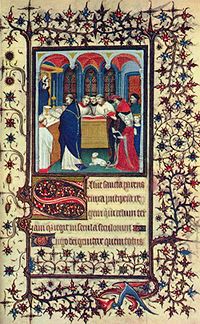Post an example of a scroll.
What were the drawbacks of the scroll?
It only had sequential usage. (It had to be read the way it was written.)
Post an example of a codex.
What is a codex?
a covered and bound collection of hand written pages.
"Codex" is derived from the Latin meaning "block of wood". Why?
They were originally bound on blocks of wood.
What is the difference between "sequential access" and "random access"?
Sequential access forces you to process the information in a certain order (a novel).
Random access can be used to find a certain selection at any given time. (Reference book)
What were the advantages of using the codex?
Compactness, sturdiness, and ease of reference.
What helped spread the use of the codex?
The rise of Christianity.
What replaced papyrus? Describe the process used to create it?
Parchment. It is a substrate made from animal skin such as sheep, goats, and cows.
What is vellum?
Finer qualities of parchment made form skins of young calves.
Name several examples of current technology that utilizes the format of the codex?
Digital e-book readers.
What led to a period of cultural and economical deterioration?
The decline of the Roman Empire.
Post an example of an illuminated manuscript.
Who began creating books by hand, taking the creation to an art form?
Monks.
What does "illumination" refer to? What was included in this ornamentation?
The pictures and ornamentation added to each page of text. Tgis included initials of chapters or paragraphs, and paintings in margins.
What tool was used for creating the illuminated manuscripts?
Natural quill pens.
Why were these manuscripts reserved for religious purposes?
The work was highly laborious.
What is craftsmanship? Why is it important?
A term used to describe mastery. It is important because of the work used to make the term work.



No comments:
Post a Comment